Key Findings
- London, the No. 1 city in the comprehensive ranking for the sixth year in a row, further extends its lead over the competition by improving its scores for such indicators as GDP Growth Rate and Level of Political, Economic and Business Risk in Economy, and for Attractiveness of Dining Options and Number of Visitors from Abroad in Cultural Interaction.
- New York (No. 2) increases its scores for the Economy indicators of Nominal GDP and GDP Growth Rate, but fails to make any significant headway in comprehensive score, having returned weaker scores this year in Cultural Interaction indicators such as Number of World-Class Cultural Events Held and Livability indicators like Variety of Retail Shops.
- Tokyo claimed the No. 3 ranking for the first time last year and closes the gap on New York (No. 2) this year. This is a result of the American city’s score stalling while Tokyo continues to improve every year in the Cultural Interaction indicators of Number of Visitors from Abroad and Number of International Students. However, Japan’s capital city slips from No. 1 to No. 4 in Economy due to weaker scores in “Market Size” and “Market Attractiveness.”
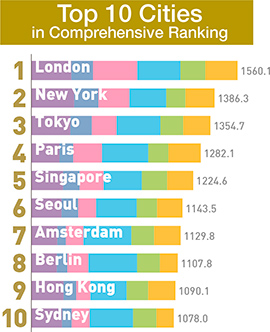
GPCI SUMMARY
“Global Power City Index 2017 Summary” uses figures and charts to clearly introduce a city’s power through the lens of 6 functions (Economy, R&D, Cultural Interaction, Livability, Environment, Accessibility) covered in the Function-Specific Ranking, as well as through the viewpoint of 5 urban actors (Manager, Researcher, Artist, Visitor, Resident) in the Actor-Specific Ranking.
Detailed information on the results of these rankings can be found in “Global Power City Index Yearbook 2017”, which is expected to be released in January 2018.
GPCI 10th Anniversary
Started in 2008, the Global Power City Index has reached its tenth year. Up until now, several top cities have shifted their ranks, such as London replacing New York at the top position (GPCI-2012), and Tokyo jumping over Paris to claim the No. 3 spot (GPCI-2016).
While London is currently leading strongly in the No. 1 position, several upcoming events, such as the U.K.’s withdrawal from the EU in March of 2019, or the 2020 Tokyo Olympics, are expected to heavily influence city power. From here on out, how will the competition between cities continue to change?
Click here to open the PDF file
PRESS RESOURCES
-
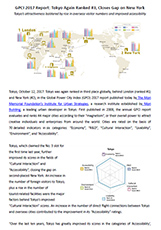
-
Press Release
PDF Download
-
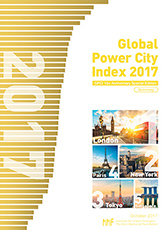
-
Summary
PDF Download
-
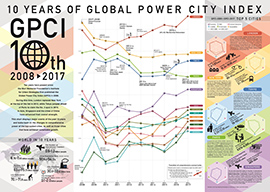
-
10th Anniversary Special Feature
PDF Download
-
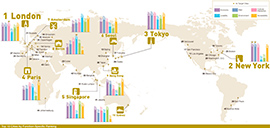
-
Top 10 Cities by Function-Specific Ranking
JPEG Download
-
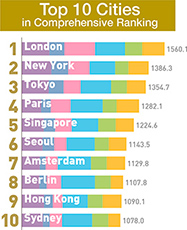
-
Top 10 Cities in Comprehensive Ranking
JPEG Download
-
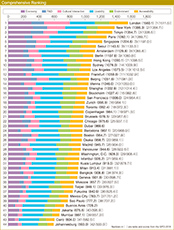
-
Result of Comprehensive Ranking
JPEG Download
-
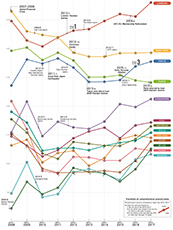
-
Transition of Comprehensive Score/Ranks (13 Cities)
JPEG Download
-
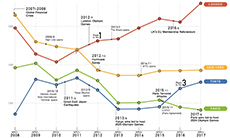
-
Transition of Comprehensive Score/Ranks (Top 4 Cities)
JPEG Download
PUBLICATIONS
For more information about the Global Power City Index, please see the Summary or order the YEARBOOK. You can download the PDF version of the Summary below. The YEARBOOK provides specific details on the methods of research, definition of indicators, lists of data sources, and scores and ranking analysis of each city.
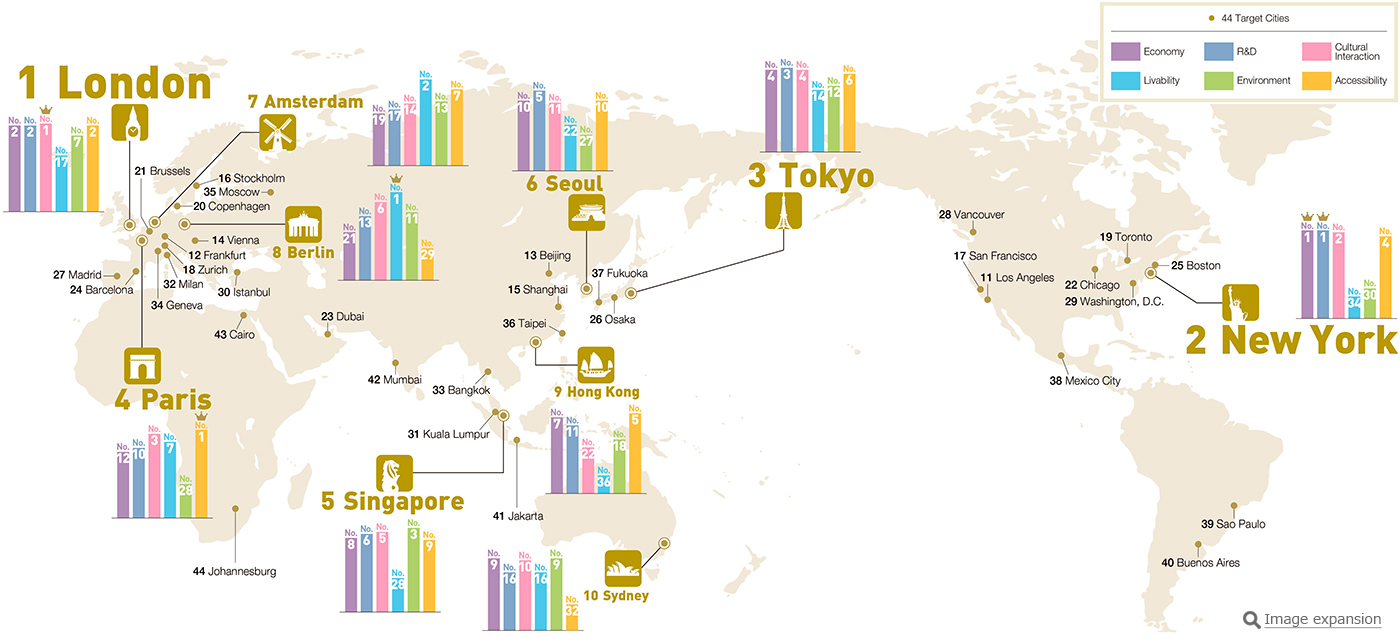
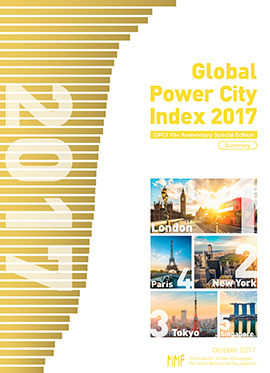
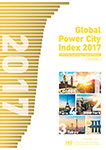

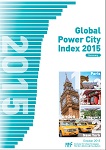
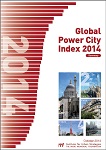
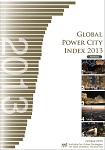
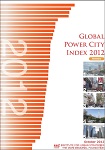
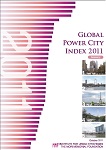
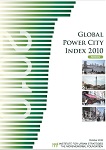
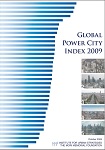
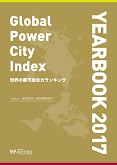
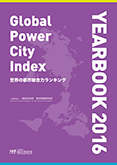
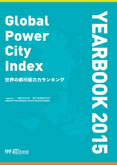
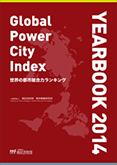
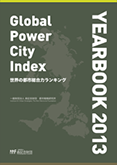
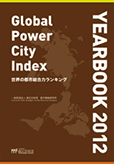
MESSAGES FROM THE COMMITTEE
This year marks the tenth year since the GPCI was first published in 2008. Looking back over the past 10 years, the world's cities were faced with a global financial crisis stemming from the American subprime loan predicament in 2007, and then crossing several years since the beginning of the GPCI, results for top cities like London and New York have continued to fall.
Although there are many cities which have failed to recover their scores to the same level as before the global financial crisis, there is still a city whose urban power has steadily grown. That city, which has been No. 1 for six consecutive years, is London. The city, which hosted the Olympic Games and jumped over New York to claim the No. 1 position in 2012, has continued to see its scores improve after the Olympics while the gap between itself and the No. 2 position grows larger every year.
In order for Tokyo to take over London's No. 1 rank, it will have to maintain even stronger mid-range growth than London. To do so, both the public and private sectors will have to abandon preconceived notions and work together to proactively seek dynamic regulatory reforms that encourage innovation. I hope that the Tokyo Olympics as a national event can act as an accelerator, causing visible change to the city.
Heizo Takenaka
Professor, Toyo University
Professor Emeritus, Keio University
Chairman, Institute for Urban Strategies,
The Mori Memorial Foundation
The chronological changes in score over the past 10 years of the GPCI show how cities around the world have seen their urban power affected relatively in the global context. While the largest cause of these score changes is economic, and at times scores drop due to macroeconomic conditions, there are still cities that have managed to overcome individual challenges in Livability, Environment, and Accessibility, improving their function scores.
Looking back at the past ten years for Tokyo, Accessibility and Cultural Interaction which were somewhat weaker compared to the top 2 cities, have achieved higher results, while the city overtook Paris to become No. 3 in 2016. This year as well, Tokyo's comprehensive score rose further, allowing it to close the gap and draw closer to 2nd place New York. Although the city's No. 1 position in Economy, which it had maintained for the past 6 years, dropped to the No. 4 spot in GPCI-2017, all of Tokyo's individual functions received high scores, showing that the city has become more balanced.
Within the power relations of the coming years, it will be indispensable for cities to grasp the trends shown by benchmarked rival cities while understanding the appeal as well as challenges faced, in order to increase their urban power. It is because of this need for a comprehensive index that the GPCI exists, and we hope that it will continue to be of further use to various people in drafting urban policies and business strategies.
Hiroo Ichikawa
Professor and Dean, Professional Graduate School of Governance Studies, Meiji University
Executive Director, The Mori Memorial Foundation
COMMENTS FROM MAYORS
London is the best place in the world to do business.
With its unrivalled talent pool, the presence of a huge number of global businesses across all sectors, and access to regulators, business support services and vital European markets, London is the best place in the world to do business.
What's more, the capital's cultural attractions, food scene and sporting calendar are world-leading – just a few of the reasons London is such an attractive place to live and work.
Sadiq Khan
Mayor of London
Three cities in one: a Safe City, a Diverse City, and a Smart City
Tokyo, host of the 2020 Olympic and Paralympic Games in three years, is a charming city where tradition and innovation come together – where “Old Meets New” and nature blends with a modern landscape. It is a vibrant city brought alive by exceptional human resources, information, technology and culture that coexist and interact. We have clean air and water, public safety, transportation networks and hospitality that are renowned around the world.
As we refine our city, we face challenges posed by a declining birthrate, an aging and shrinking population, natural disasters and climate change. In response, we are proceeding with a grand reform of Tokyo to create three cities in one: a Safe City where people feel more secure and at ease; a Diversity – or Diverse City – where everyone can actively participate; and a Smart City open to the world and an environmental and financial leader.
Looking beyond the Tokyo 2020 Games, we plan to create a New Tokyo capable of widespread sustainable growth.
Yuriko Koike
Governor of Tokyo
Global and people-oriented city, where people can walk, work, and live comfortably
Seoul has three landmarks: people, history, and nature. Seoul is blessed with talented people, 2,000-year-long history, and beautiful nature. One of Seoul’s strengths is advanced information technology and rich cultural contents. Another one of Seoul's competitive edges is ability to adapt to changes and drive innovation. It was this dynamism that enabled Seoul to grow to become the city it is today, with economic prosperity and quality of life. Over the past decade, Seoul has seen GRDP per capita grow by 1.5 times and number of employees increase by 1.2 million. In 2016, Seoul was ranked first in the ‘people’ sub-index on the Sustainable Cities Index.
Nevertheless, Seoul will not remain complacent. Seoul aspires to become a global and people-oriented city, where people can walk, work, and live comfortably. People will be proud to be citizens of Seoul, and more tourists will want to visit Seoul. But there are several challenges that Seoul needs to address. Seoul will carry out policies to create jobs for the youth and seniors, develop an R&D cluster, promote tourism, MICE, and entertainment industries, establish green transportation, and pursue balanced growth through urban renewal.
Park Won-Soon
Mayor of Seoul
We will remain a global, liveable hub that is attractive to all.
Today's global economy revolves around urban areas. These global hubs, including Amsterdam, are a magnet for international events, talent and fast-growing multinational companies. In addition, they’re a breeding ground for innovation, knowledge and startups.
What sets Amsterdam apart from other cities is that it's more than just a cosmopolitan and international city – it's also compact, liveable and full of village-like charm. It's crucial to maintain and further develop these conditions to help the city's residents and companies continue to flourish. Therefore, Amsterdam – and its surrounding region – has implemented ambitious plans to further invest in infrastructure, international schools and the office and housing market. We will remain a global, liveable hub that is attractive to all.
Eberhard van der Laan
Mayor of Amsterdam *as of September 2017
Make Vienna a place where innovation can flourish even more than before
Vienna's main strength is the city's holistic and interdisciplinary approach that unites actors from different municipal areas and organizations. Vienna combines sustainable, innovative and – most of all – social aspects to guarantee and maintain Vienna’s high quality of life.
The city works towards this aim in many projects. One concrete example of such an initiative are the Citizens’ Solar Power Plants run by the city-owned energy provider Wien Energie. Another example is the project “aspern Vienna’s Urban Lakeside”, where in the future, 8,500 housing units will accommodate 20,000 people. With a 240-hectare project area, it is one of Europe's largest urban developments—a city within the city.
For the future, Vienna wants to significantly reduce the consumption of resources in the city. At the same time, the city will continue offering the highest quality of life and social cohesion for all citizens. We will meet these challenges if we take a proactive approach to change and make Vienna a place where innovation can flourish even more than before.
Dr. Michael Häupl
Mayor of Vienna